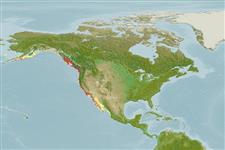Classification / Names
Common names | Synonyms | Catalog of Fishes (gen., sp.) | ITIS | CoL | WoRMS | Cloffa
Actinopterygii (ray-finned fishes) >
Perciformes (Perch-likes) >
Scombridae (Mackerels, tunas, bonitos) > Scombrinae
Etymology: Sarda: Latin and Greek, sarda = sardine; name related to the island of Sardinia (Ref. 45335).
Issue
This species was usually referred to as a subspecies of Sarda chiliensis Cuvier, 1832. Until further work, it is elevated here at species rank following Clemens & Wilby (1961: Ref. 4925).
Environment / Climate / Range
Ecology
Marine; pelagic-neritic; oceanodromous (Ref. 51243). Subtropical, preferred ?; 61°N - 20°N
Northeast Pacific: Off the coast of Alaska (60°16'N, 145°32'W) to Cabo San Lucas at the tip of Baja California (22°20'N, 112°27'W) and Revillagigedo Islands.
Size / Weight / Age
Maturity: Lm ? range ? - ? cm
Max length : 102 cm FL male/unsexed; (Ref. 168); max. published weight: 11.3 kg (Ref. 168)
An inshore species that forms schools by size (Ref. 168). Feeds on a variety of small schooling fishes, squids and shrimps (Ref. 168). An important food fish (Ref. 4925).
Life cycle and mating behavior
Maturity | Reproduction | Spawning | Eggs | Fecundity | Larvae
McAllister, D.E., 1990. A list of the fishes of Canada. Syllogeus No. 64. Nat. Mus. Nat. Sci., Ottawa, Canada. 310 p. (Ref. 11980)
IUCN Red List Status (Ref. 115185)
CITES (Ref. 94142)
Not Evaluated
Threat to humans
Harmless
Human uses
Fisheries: commercial; gamefish: yes
More information
ReferencesAquacultureAquaculture profileStrainsGeneticsAllele frequenciesHeritabilityDiseasesProcessingMass conversion
Tools
Special reports
Download XML
Internet sources
Estimates of some properties based on models
Phylogenetic diversity index (Ref.
82805): PD
50 = 0.5312 [Uniqueness, from 0.5 = low to 2.0 = high].
Trophic Level (Ref.
69278): 4.2 ±0.60 se; Based on food items.
Resilience (Ref.
69278): Medium, minimum population doubling time 1.4 - 4.4 years (K=0.6).
Vulnerability (Ref.
59153): Moderate to high vulnerability (51 of 100) .
